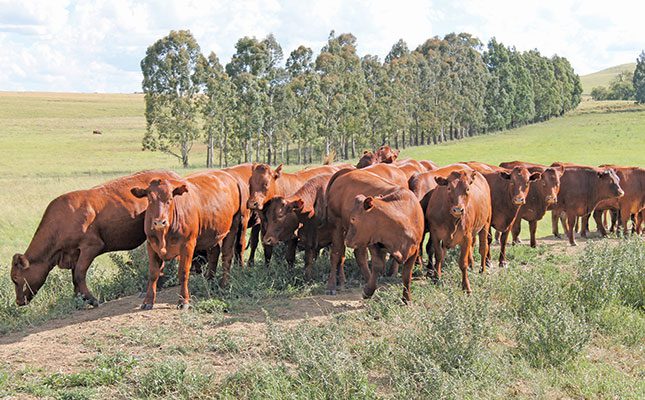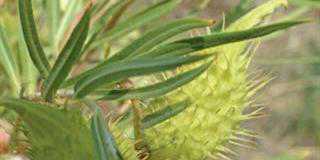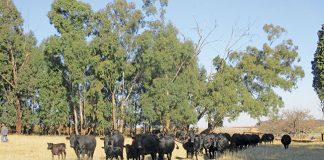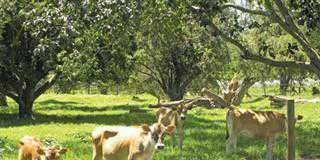
Photo: Lindi Botha
For most South African farmers, surviving the cost-price squeeze is a far greater consideration than reducing methane emissions.
While South Africans are not currently facing pressure to reduce carbon footprints like Europe and the US, emissions will need to be tackled in the near future.
Considering the pressure the livestock industry faces globally for their methane emission contribution to greenhouse gases (GHG), it is expected that SA farmers will not be spared the scrutiny.
READ Farming smarter can reduce methane emissions from livestock
The good news is that, as the focus on methane emissions from livestock production has intensified, so has research to reduce methane production in livestock. And as gene sequencing has become common among breeders to select the right qualities for their herd, genes that reduce methane are under the spotlight.
About 90% of methane from cows is excreted by burping rumen gases from their mouths. This is a rumen fermentation by-product and is often referred to as enteric methane emissions.
Multiple studies now show that the cow’s genetic make-up accounts for 24% of methane emission variation, with another 7% attributed to the rumen microbiome.
Determining what genes affect rumen gases, and what effect these genes will have on production if deselected, has become a burning question, and one that requires far more research before conclusions can be drawn.
The Food and Agriculture Organization of the United Nations’ (FAO) report on methane emissions in livestock, published in September last year, states that at present there are only a few instances where methane is taken into consideration in breeding programmes across the world.
Commercial trial
This includes a large-scale commercial trial with sheep farmers in New Zealand, and a programme in the Netherlands which integrates methane emissions into dairy breeding values.
Various possible modes of action have been identified in the study to reduce methane production: lower feed requirement, increased feed efficiency, increased feed digestibility, decreased rumen size, increased rate of passage, improved health, a different rumen-fermentation profile, hydrogen dynamics and methanogen activity.
The magnitude of possible methane mitigation is, however, not fully understood. Earlier studies have been relatively small-scale and the FAO notes that larger-scale studies are needed to draw definitive conclusions on the potential for including methane in breeding programmes.
Researchers are, however, having a tough time deciding on which traits to focus on to reduce methane, without negatively influencing production.
Challenges with measuring
Coralia Manzanilla Pech, a researcher at the Centre for Quantitative Genetics and Genomics at Aarhus University in Denmark, believes that selecting animals with low-methane emissions is a strong approach to reduce methane, given that genetic progress is permanent and cumulative over generations.
She, however, identifies a number of challenges with measuring and lowering methane production. First, genetic selection requires a large number of animals with records to predict accurate breeding values.
“Currently, the data available on methane emissions are scarce or non-existent in most countries, as measuring methane is expensive and labour intensive, and targeting methane reductions has only gained impetus in the last decade.
“However, combining data from different countries is a good solution to increase data set size and subsequently improve accuracy of genetic parameters for methane production, compared with only using data from one country,” according to Pech.
She adds that in spite of the increase in research projects on methane emissions, there is a lack of consensus on the most appropriate trait to be included in the breeding goal.
“Should it be daily methane production in grams per day, per cow, regardless of the correlation with traits such as milk yield, body weight, and dry matter intake, which are already included in the breeding objective?
“Alternatively, should it be a ratio trait such as methane yield to dry matter intake, or methane intensity to energy-corrected milk, or a residual methane trait, adjusted by metabolic body weight, energy-corrected milk or dry matter intake? An important but rather subtle distinction must be made between breeding objective traits and selection index traits, as they are not always the same.”
READ Correct feeding can slash dairy cows’ methane emissions by 30%
She explains that the breeding objective could be to improve methane intensity, but to achieve this, methane production and energy-corrected milk traits are included in the selection index and not methane intensity directly.
“Deciding on the relative merit of different breeding objectives and different traits included in the selection indices requires knowledge of their genetic factors. Genetic correlations between methane traits and efficiency traits are therefore needed to help clarify the genetic background behind the energy losses and to help identify the most appropriate methane trait to be included in the breeding objective.”
Global consensus
Since methane production is highly correlated with other economically important traits such as milk production, weight, and feed intake, Pech believes it is important to have a trait that is adjusted for the production traits.
Residual methane adjusted by metabolic body weight and energy-corrected milk is the best option, she says.
While global consensus is still being found for a methane-trait selection process, there is one company that has taken the plunge and released semen with low-methane traits.
Semex, based in Canada, is the first company to provide such semen globally, focusing solely on Holsteins, for now.
Protein, fat yield
Semex markets these genetics according to a methane efficiency index, which takes into account methane production at the same level of milk, fat and protein yield.
This means that while genetics have been selected for lower methane production, milk production has not been penalised.
The company says dairy producers can expect to achieve 20% to 30% reduction in methane emissions from their herd by 2050, depending on their selection pressure.
While this development holds much promise, Semex has faced criticism for possibly causing digestibility problems in cows by lowering methane production.
Smaller guts
With the microbe population of the gut playing a big role in methane production, researchers have suitably turned their attention to cows’ stomachs in a bid to lower emissions.
Smaller frames
Nadiia Stepanchenko, a researcher at the Department of Animal Science at Pennsylvania State University in the US, found that cattle with low methane production tend to have smaller frames, and house different microbial communities, than those with higher methane output.
These differences were not associated with reduced milk production or altered milk composition.
Stepanchenko explains that genetics affect how energy is partitioned within the rumen of sheep, and beef cattle.
“With bigger-framed animals having larger guts and rumen capacity, food tends to take longer to pass through the digestion system, allowing for greater digestibility. This is believed to contribute to methane production, since smaller-framed animals with smaller rumen capacity, and consequently a shorter feed retention time, produce less methane.”
READ UK project aims to reduce methane emissions in sheep
She notes that while most studies aimed at understanding the differences between high and low methane emitting phenotypes do not take production variables into consideration, there has been evidence that shows increased dry matter intake and energy correct milk yield for low methane cows.
Her research found that cows dubbed as high-methane emitters have 21% more daily methane emissions, a 24% higher methane yield, and a 22% increase in methane intensity compared with low methane cows. Overall, Stepanchenko believes that selecting for smaller framed animals will play a big part in reducing methane emissions on dairy farms.
Measurement challenges
Perhaps a far greater issue than finding the right selection criteria, is measuring progress. The FAO believes that the ability to measure methane is one of the biggest challenges in reducing emissions.
Their research states that while precise methods have been developed, often involving placing animals in respiration chambers, they are expensive, labour-intensive, and difficult to apply to grazing animals.
Sophisticated use of drones and satellites have been deployed, but this approach entails much modelling, and research is lagging behind in validating these methods.
Moreover, enteric emissions can vary substantially between animals of the same species, and an investigation of genotype by environment interaction would determine whether optimum genetics identified in one country is suitable for another country or region.
Interactions with diet types also need to be explored. The FAO explains that assessing an animal’s methane phenotype is difficult because methane must be measured over an extended period.
Despite a lack of a clear path forward for deselecting methane traits, the rate of progress is encouraging and South African farmers are sure to benefit from the trial and error in methane-focused countries in future.
Email Coralia Manzanilla Pech at [email protected], or Nadiia Stepanchenko at [email protected].










